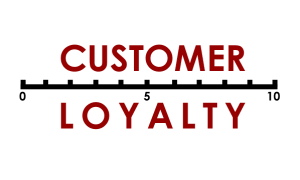 Developing measures of customer loyalty using survey questions is a scientific endeavor; these loyalty measures are typically customers’ self-reported likelihood of engaging in future loyalty behaviors. Because self-reported metrics are necessarily fraught with measurement error, I have argued for using psychometrics as a way of evaluating these “soft” metrics. Psychometrics helps you understand the reliability and validity of your loyalty metrics and needs to be considered whenever you are measuring customers’ attitudes/perceptions/opinions.
Developing measures of customer loyalty using survey questions is a scientific endeavor; these loyalty measures are typically customers’ self-reported likelihood of engaging in future loyalty behaviors. Because self-reported metrics are necessarily fraught with measurement error, I have argued for using psychometrics as a way of evaluating these “soft” metrics. Psychometrics helps you understand the reliability and validity of your loyalty metrics and needs to be considered whenever you are measuring customers’ attitudes/perceptions/opinions.
While the details of psychometric analysis of survey questions might be lost on most readers, there are other, less mathematically demanding, ways to evaluate loyalty metrics. I was recently asked about the merits of the RAPID loyalty approach (based on my research on customer loyalty questions) and responded via my mobile phone (hyperlinks and summary section added later). My response is below. I might use this writing approach from time to time as it forces me to be brief and concise.
1. Loyalty metrics need to be comprehensive.
Different types of loyalty behaviors from your customers lead to different types of business growth. Sure, customers can recommend you to their friends (e.g., advocacy loyalty). But they can also expand their existing relationship with you (e.g., purchasing loyalty) and also stay with you for a long time (e.g., retention loyalty). Measuring advocacy, purchasing and retention loyalty helps companies understand how to optimize all three types of loyalty, each responsible for different types of business growth.
Bottom line: You can’t manage what you don’t measure. Measure different types of customer loyalty.
2. Loyalty metrics need to be clear and meaningful.
We use all data to calculate loyalty scores and the scores themselves are on an understandable scale. We simply take the average of all responses to get to our scores. So, scores can range from 0 to 10, 10 being the highest possible score. Another popular loyalty measurement approach uses only a portion of the customer feedback to calculate a score (e.g., Net Promoter Score does not include a customer segment (customers who rate you as 7 or 8) in its calculation; the resulting net score of the two remaining segments is on a scale from -100 to 100 where 0, the midpoint of the NPS scale, is actually a good/positive response (around 7 on a 0-10 scale). Net scores make sense when you translate them back to the original rating scale. So, why not just use the original 0 to 10 scale?
Bottom line: Mean scores and top/bottom box scores are better summary metrics than net scores. This is true for any customer experience metric, not only loyalty questions.
Summary
I have previously outlined four things you need to know about your customer metrics. To be of value to your company, customer loyalty metrics: 1) need to be supported by a clear description of what they are measuring; 2) must have a clear method of arriving at a score (clear calculation); 3) need to have good measurement properties (reliability and validity found using psychometric analysis); and 4) must help you gain customer insights to grow your business.
In this blog post, I focused on the less mathematically rigorous criteria for customer loyalty metrics. For sure, you will be in a better position to achieve sustainable business growth when you comprehensively measure all types of customer loyalty (it is multi-dimensional, after all) and when those customer metrics are easy to understand.
In an unscientific poll of webinar attendees regarding their companies’ use of customer loyalty measures, I found that many companies’ loyalty metrics are insufficient. Specifically, while most companies typically measure advocacy loyalty (76%), only a few companies measure purchasing loyalty (33%) or retention loyalty (30%). What customer loyalty metrics does your company measure?



 Beyond the Ultimate Question
Beyond the Ultimate Question Measuring Customer Satisfaction and Loyalty (3rd Ed.)
Measuring Customer Satisfaction and Loyalty (3rd Ed.)
[…] Image Source : Business Broadway […]